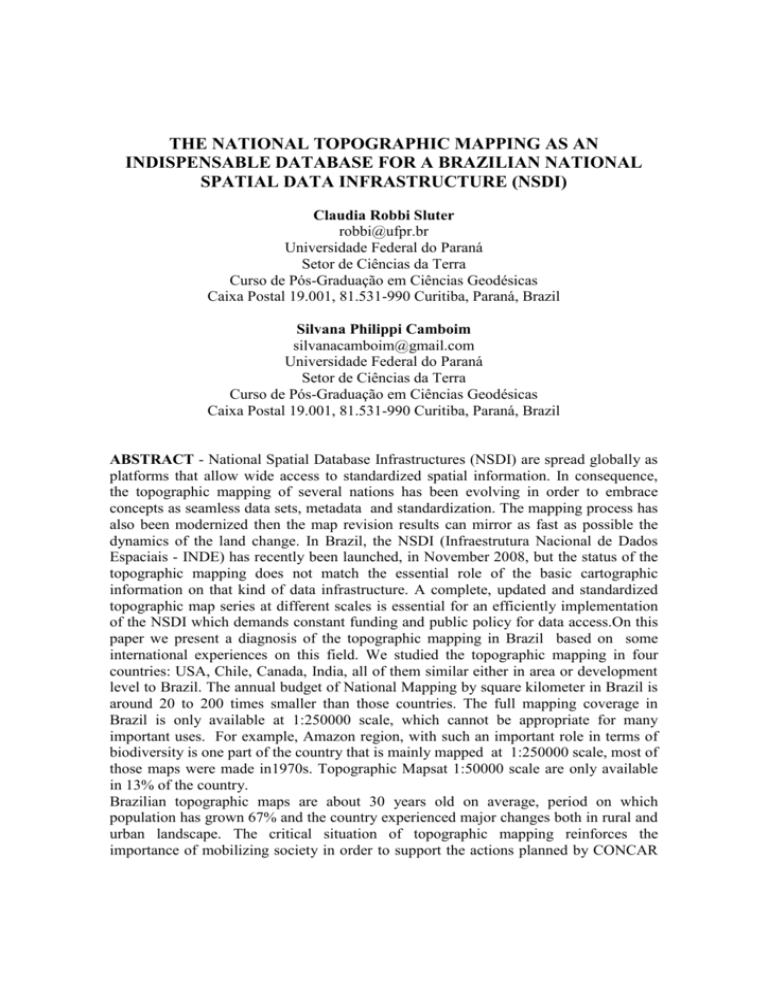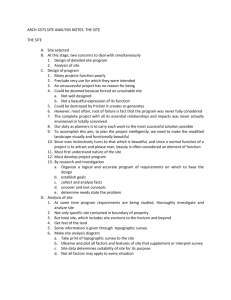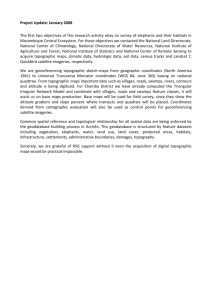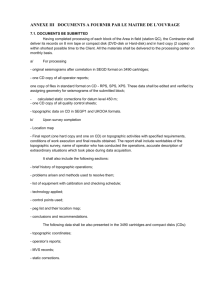the national topographic mapping as an indispensable
advertisement

THE NATIONAL TOPOGRAPHIC MAPPING AS AN INDISPENSABLE DATABASE FOR A BRAZILIAN NATIONAL SPATIAL DATA INFRASTRUCTURE (NSDI) Claudia Robbi Sluter robbi@ufpr.br Universidade Federal do Paraná Setor de Ciências da Terra Curso de Pós-Graduação em Ciências Geodésicas Caixa Postal 19.001, 81.531-990 Curitiba, Paraná, Brazil Silvana Philippi Camboim silvanacamboim@gmail.com Universidade Federal do Paraná Setor de Ciências da Terra Curso de Pós-Graduação em Ciências Geodésicas Caixa Postal 19.001, 81.531-990 Curitiba, Paraná, Brazil ABSTRACT - National Spatial Database Infrastructures (NSDI) are spread globally as platforms that allow wide access to standardized spatial information. In consequence, the topographic mapping of several nations has been evolving in order to embrace concepts as seamless data sets, metadata and standardization. The mapping process has also been modernized then the map revision results can mirror as fast as possible the dynamics of the land change. In Brazil, the NSDI (Infraestrutura Nacional de Dados Espaciais - INDE) has recently been launched, in November 2008, but the status of the topographic mapping does not match the essential role of the basic cartographic information on that kind of data infrastructure. A complete, updated and standardized topographic map series at different scales is essential for an efficiently implementation of the NSDI which demands constant funding and public policy for data access.On this paper we present a diagnosis of the topographic mapping in Brazil based on some international experiences on this field. We studied the topographic mapping in four countries: USA, Chile, Canada, India, all of them similar either in area or development level to Brazil. The annual budget of National Mapping by square kilometer in Brazil is around 20 to 200 times smaller than those countries. The full mapping coverage in Brazil is only available at 1:250000 scale, which cannot be appropriate for many important uses. For example, Amazon region, with such an important role in terms of biodiversity is one part of the country that is mainly mapped at 1:250000 scale, most of those maps were made in1970s. Topographic Mapsat 1:50000 scale are only available in 13% of the country. Brazilian topographic maps are about 30 years old on average, period on which population has grown 67% and the country experienced major changes both in rural and urban landscape. The critical situation of topographic mapping reinforces the importance of mobilizing society in order to support the actions planned by CONCAR (National Cartography Commission) on the subject, and to demand suitable amount of investments in cartography. Investments on topographic mapping are an urgent measure to make it possible to Brazilian NSDI to achieve its aim which is to promote appropriate level of quality on spatial data creation, sharing and use; and consequently to avoid duplicate efforts. Comparing the achievements of the studied countries we realized the importance in participating more actively in international SDI community in order to share experiences and technology with institutions that already had taken a long journey implementing SDIs and adapting National Mapping Systems and surely have a lot of lessons already learned. Only with a growing sense of the importance of these investments that Brazil can achieve the same institutional synergy that was the basis to NSDI development in such a lot of countries around the world. And also, it is due mainly to Brazilian geoinformation community to unite themselves in order to present to society the urge for a complete and updated National Maps database and the gains that can be obtained in terms of sustainable development and social equity that these investments can achieve. 1. INTRODUCTION Spatial database infrastructures (SDIs) can be described as “relevant base collection of technologies, policies and institutional arrangements that facilitate the availability of and access to spatial data” (Nerbert, 2004) . They are organized structures that contains a series of components as data content, metadata, online catalogues, interoperability standards, which demands for public policies to share spatial data and to prepare map users. SDIs are built in such a way that they can be grouped to exchange information in different levels. On this article, we examine specially National SDIs. National Spatial Database Infrastructure was first studied in the beginning of 1990’s. In 2001, Coproevet et al. identified more than 120 countries with NSDI in process of establishment. The first NDSI are now more than 10 years old, and among the pioneers initiatives we can emphasize: USA (1994) and Australia (1996). At Latin America, many NSDI are already formalized and operational, as in Colombia, Venezuela, Uruguay, Argentina and México. In 1996 was created the Global Spatial Data Infrastructure Association, that organizes biannual conferences and publishes the SDI Cookbook (Nerbert et al., 2004), a guide for SDI implementation. The Statement of Santiago, result of the 9th GSDI Conference, held on Chile in 2006, reinforces the importance of spatial information to SDIs: “Spatial information is a public asset. Governments around the world must make efforts to make access to it freer, enabling shared development, interrelated and standardized for both public and private organizations that use it. This information is an important element for our countries, becoming a basis for economic growth, encouraging public and private investment and consequently generating economic and social development. Governments must invest in the development, implementation, application and use of spatial information, consequently making contributions to the budgets of the bodies which create territorial information, in order to produce, maintain and publish the spatial data that sustains development in these countries, oriented to a continuous improvement of the standards and lives of the people of our planet.” On this context, National Mapping Systems are experiencing a deep transformation. All processes must be re-designed in order to incorporate concepts as database management, spatial data modelling and dynamic updating which are required by the new technological demands. In Brazil, the National SDI (in Portuguese, “Infraestrutura Nacional de Dados Espaciais” – short INDE) was established by a federal government decree in November, 2008. The National Commission on Cartography (in Portuguese, “Comissão Nacional de Cartografia” – short COCAR) is the responsible for INDE major coordination ,. This comission was reactivated in 2004, after a period of inactivity since 1999. According to CONCAR strategic plan defined in 2005 its mission is “to coordinate and to guide the creation and execution of National Policy for Cartography, and to maintain the National Mapping System, which objective is to organize the geospatial data acquisition, production and dissemination to Brazilian Society”. The first steps for establishing a INDE in Brazil are already implemented as for example the creation of the “Mapoteca Nacional Digital”, a spatial data model to topographic mapping, some metadata standardization and projects to pursue financial sources to improve the cartographic base. 2. BRAZILIAN NATIONAL TOPOGRAPHIC MAPPING The XXI Article of the Brazilian Federal Constitution states the responsibility of the federal government for organizing and maintaining the official services of statistics, geography, geology and cartography on a national level. The Brazilian Institute for Statistics and Geography, short IBGE, is the state owned central agency responsible for the national topographic mapping, which is ruled by the decree-law # 243 of February, 28 1967. According to the VII and VIII Articles of this decree-law: “Art. VII – The topographic mapping represents the Brazilian territory by a series of maps selectively and progressively produced in accordance with society priorities and aeronoutics, nautics, and topographic mapping standards.” “Art. VIII – The Official Topographic Mapping is intended to the representation of the national territory by a series of adjacent and homogenous quadrangle maps at the standard scales 1:25000, 1:50000, 1:100000, 1:250000 and 1:1000000.” Although the law obligation mapping the territory is highly deficient in Brazil, which is a consequence of 2 problems: first there are only parts of the country mapped at 1:25000, 1:50000, 1:100000, 1:250000 scales, and second there is not a map revision program. Therefore a number of topographic sheets at different scales are out-of-date. The oldness of a considerable amount of topographic maps have consequences for the Brazilian society. One of them is the necessary investment to update the existing topographic maps. An example of the low level of reliability of spatial data because of the age of the map is shown in the figure 01. This figure depicts a part of the “Rio Negrinho” topographic sheet at 1:50000 scale, which is the newest topographic map of the region. This map was made from aerial photographs taken 42 years ago (in 1966). In order to compare the urban area today with its limits depicted in the official map an orthophotography of the same region taken in 2005 is shown at the right. Figure 01: at left, “Rio Negrinho” Topographic Sheet (IBGE, photogrammetric survey in 1966 )and at right oOrthorectified image of the same area. The red line shows the urban area boundary in 1966 and black line shows the urban area in 2005. Some information about topographic maps at every scale related to the amount of printed sheets and the oldness of the data survey is presented in the following sections. The information was obtained from IBGE internet site, which was updated in 1998. We believe there are topographic maps made after 1998, however we could not find more recent information about it. Besides the 1:1000000 sheets the whole country is mapped only at 1:250000 scale. This scale is not appropriate for the level of detail required for most of spatial analysis applications. In figure 02 we can notice that the most critical situation is in the Amazon region of where this scale maps are the only ones available for a large part of this region. Table 01 presents the problem about 1:250000 topographic maps aging in Brazil and figure 02 illustrates the their spatial distribution. Number of sheets 953 Average year of the last revision 1979 Average time since the last 29 years revision Number of sheets older than 30 373 (39%) years Number of sheets between 20 569 (60%) and 30 years old Number of sheets printed after 20 11(around 1%) years ago Percentage of the territory area 99,3% Table 01: Some information about 1:250000 topographic mapping and figure 03: Histogram of the number of 1:250000 topographic maps and the year that they were printed. Figures 04, 05 and 06: Spatial location of the 1:250.00 and 1:50.000 topographic maps according to their year of print. Number of sheets 2000 Average year of the last revision 1979 Average time since the last 29 years revision Number of sheets > 30 years 834 (42%) Number of sheets between 20 1139 (57%) and 30 years old Number of sheets printed after 20 27(around de years ago 1%) Percentage of the territory area 67,7% Table 02: Some information about 1:100000 topographic mapping and Figure 07: Histogram of the number of 1:100000 topographic maps and the year that they were printed. The 1:100000 and 1:50000 topographic maps allow for the some spatial analysis which needs a more detailed representation. However the map revision is very deficient. Besides today we have only 70% of the territory mapped at 1:100000, and even more problematic situation, 13% mapped at 1:50000. Among the official scales for topographic mapping the 1:25000 maps cover the smallest region, around 1% of the country territory. Number of sheets 1675 Average year of the last revision 1977 Average time since the last 31 years revision Number of sheets > 30 years 802 (48%) Number of sheets between 20 728 (42%) and 30 years old Number of sheets printed after 20 175 (10%) years ago Percentage of the territory area 13% Table 03: Some information about 1:50000 topographic mapping and Figure 08: Histogram of the number of 1:50000 topographic maps and the year that they were printed. Since the average year of the last 1:50000 map revision, 1977, the Brazilian population grew 62%, from 115 million people to 187 million, according to IBGE and the degree of urbanization increased from 67% to 84% of the population. The urban population growth can show us the great level of changes in those regions which are not been updated in the topographic maps. 3. SOME INTERNATIONAL EXPERIENCES ABOUT TOPOGRAPHIC MAPPING AS A SUPPORT FOR NSDI In order to compare the Brazilian Topographic Mapping System with the world scenario of National Mapping Systems today, we selected four countries with distinct characteristics. All chosen countries have some degree of similarity to Brazil considering either the territorial extent or socio-economical conditions. The comparative analysis is based on total annual budget and annula budget per square kilometer to official mapping, largest scale of national mapping and respective number of sheets, map revision policy, country area, GDP and the annual budget percentage of GDP. Those criteria values for each country are described on table 04 (the references for the figures are cited in the text below). Country Annual budget (dollars) Largest Scale of National Mapping Number of sheets Country USA Canada $150.000.000,00 $239.000.000,00 1:50.000 and 1:24.000 (only 1:250.000 Alasca at (northern 1:63.000) regions) Around 57.000 USA 13.672 Canada Chile India Brazil $2.000.000,00 $44.449.741,00 $ 919.808,00 1:50000 and 1:250.000 1:50.000 and (see section 2) (southern 1:25.000 regions) 19393 - 1:25:000 1145 - 1:50.000 e 5060 (see section 2) e 660 - 1:25.000 1:50.000 Chile India Brazil Map Revision Policy 1500 sheets a year (2001) 10274 atualizadas com Information not Around 50 imagem de available sheets a month satélite a partir de 2001 Country USA SDI Canadian SNIT - Sistema NSDI/ National NSDI/ National INDE Geospatial Data Nacional de Spatial Database Spatial Database established on Infrastructure/ Informaciones Infrastructure Infrastructure November, 28th GeoConnections Territoriales (1994) ( 2006) 2008 (1999) (2006) Country area(km²) Gross Domestic Product (in millions of dollaras – Source: IMF) Annual budget per square kilometer Annual Budget (% of GDP) Canada Chile India (see section 2) Brazil 9.629.091 9.984.670 756.102 3.287.263 8.514.877 13.843.825 1.432.140 163.792 1.098.945 1.313.590 $15,58 $23,94 $2,65 $13,52 $0,11 0,0011% 0,0167% 0,0012% 0,0040% Table 04: Sumary of main SDI/National Mapping Indicators 0,0001% 3.1 UNITED STATES According to KELMELLIS et al, 2003, the total investment to produce the American 7.5-minute series of Topographic Maps is estimated in 1 billion dollars. However, at the beginning of the 21st century, this material was 24 years old on average, and it was not prepared to meet the new user’s needs. In an effort to modernize the process, it was created the National Map, a new online, seamless, integrated database managed by USGS (U.S. Geological Survey), institution in charge of the American topographic mapping. According to USGS (2001) the National Map is a important contribution to NSDI. The new framework contains highresolution digital orthorectified imagery, high resolution elevation data, vectorial data, geographic names, and land cover information. To create this massive data set, in 2007 around 150 millions of dollars were invested by the Umited States Federal government. A cost benefit analysis from HALSING et al, 2004 estimates net benefits of 20 billions of dollars recovering the costs in 14 years after its implementation. 3.2 CANADA In Canada, this is the moment of transition from the National Topographic Data Base (NTDB), the previous digital database of topographical charts, to CanVec, a seamless standardized database, updated by partners as the GeoBase (that includes multilevel partnerships to mapping production). Data about the number of sheets already updated are available in the document “From NTDB to CanVec” (NRC, 2007), by National Resource Canada, which Earth Sciences sector is responsible for the national cartography. Beyond the 11 themes in vector format, it will be available orthorectified imagery, gazetteer layer and a national digital elevation model (VESTER, 2008). On this new framework, cartography will be executed at 1:50,000 scale and according to the same document the total number of sheets is 13,.762. Maps are produced under international standards of metadata, GML format and another ISO specifications. In addition, there will be constant updating cycles. The budget figures are available at the site Department of Finances - Canada (www.budget.gc.ca). All data produced are freely available at the site GeoGratis (www.geogratis.gc.ca). The Canadian Geospatial Data Infrastructure – CGDI, according to ARTES(2007)was established in 1999 and at the moment are in its second phase. The budget for the first phase, from 1999 to 2005, was 60 million Canadian dollars and the prediction of more than 60 million Canadian dollars to be invested between 2005 and 2010. 3.3 CHILE The figures about the state-of-the-art of the topographic mapping in Chile were obtained from the report sent to ICA - International Cartographic Association about the cartography of the country that will organize the next ICA Conference in November, 2009. The SNIT - Sistema Nacional de Informaciones Territoriales, is composed by a set of institutions at different levels of responsibility, and have already made some tools as the Metadata Portal available, with 7600 catalogued data (IGLESIAS, 2008). The official framework is also created and planning procedures developed in order to improve the quality of available geographic information.The basic data is produced by IGM (Instituto Geográfico Militar) which is working on the ISO standardization of data and metadata and 2 million dollars annually are allocated for this activity (VARGAS, 2007). 3.4 INDIA The budgetary information for the years 2008-2009 are from the site: There are two series of maps in India: “Defense Series Maps (DSMs)”, only for the military users and the “Open Series Maps (OSMs)”, available for general public. Information about map updates are monthly published in Survey of India website. Survey of India is theinstitution in charge of official mapping of the country and one of the pioneers in the world (it was created in 1767). The NSDI was established on 2001 with a plan to invest around 10 to 20 billion of dollars (RAO, 2001). Currently, it already has an online geoinformation portal (http://gisserver.nic.in/nsdiportal/gos) to promote public access to the produced data (http://indiabudget.nic.in) 4. CONCLUSION In its strategic plan, CONCAR highlights the lack of financial resources, the lack of articulation among budgets allocation on distinct areas of government and the discontinuity of investments as obstacles for the accomplishment of National Cartography Policy. In fact, there is a series of investments in cartography, made by several actors. However, the lack of investment on official topographic mapping and revision map programme make the users pay for the production of their own maps. Althoughonly the users that can afford mapping have access to it. The majority of Brazilian society is not benefited with the results of this private or local investment. A broader and more democratic access to spatial data would increase the efficiency of the scarce resources application. Among the planned actions to improve the current state of Brazilian Topographic Mapping is the investment of 300 million dollars on the Amazon Region, to be executed by Brazilian Army’s Geographic Service (in Portuguese “Diretoria do Serviço Geografico”, short DSG –). Another action is a study by CONCAR to harmonize and update the National Mapping called “Terrestrial Cartography Growth Acceleration Program”. This project goal is to map the Brazilian territory at 1:100,000 and 1:250,000 scales, which would increase 10 times the annual budget for official topographic mapping. These initiatives are essential for the successful establishment of Brazilian NSDI. However without investment in basic cartography in order to produce larger scale maps and just making available existent and old data by an online service is not enough to achieve the objectives of the Brasilian NSDI. It is vital to Brazilian development that investments in cartography are proportional to the increasing territorial dynamics needs, and that this investment has to be made complying with international standards of interoperability and in an open and public data access environment. Only then, any citizen could enjoy the benefits of a official mapping service in a transparent and collaborative way, avoiding the current situation of working in isolated projects that often generates duplicated work and inefficient use of financial resources. REFERENCES ARTÉS, F. The GeoConnections Initiative. In: Canada’s Online Geospatial Resource, 2007. Available at: <http://www.geoinformatics.com/asp/default.asp?t=article&newsid=3106> Access: 11 July 2008 AUGUSTO, M. J. de C. and FREITAS, A. L. B. de. Esforços em Desenvolvimento para a Constituição da INDE – Brasil, In: “I Reunión Técnica conjunta de las comisiones del IPGH”, 2007. Available at: <http://www.ipgh.org/comisiones/CARTOGRAFIA/files/Itu/BRASIL_Esforcos_IDE_BR_v1revmoe.pdf> Access: 16 January 2009 BRASIL,2008 Portal da Transparência Presidência da República – Controladoria Geral da União. Available at: <http://www.portaltransparencia.gov.br/> Access: 16 January 2009 CONCAR (Comissão Nacional de Cartografia), 2005. Planejamento Estratégico. Available at: <http://www.concar.ibge.gov.br/index78f5.html?q=node/93> Access: 16 January 2009 CONCAR (Comissão Nacional de Cartografia), 2007.Ata da 13ª reunião do Comitê de Estruturação da MND – CEMND, realizada dos dias 27 à 31 de agosto de 2007 Available at: <http://www.concar.ibge.gov.br/Arquivos/Ata_13_Reuniao_27_a_31_08_2007.doc> Access: 16 January 2009 CROMPVOETS, J. ; BREGT, A. World Status of National Spatial Data Clearinghouses In: URISA Journal: Special Issue on Public Participation GIS, p 43-50, 2003 DIÁRIO DO PARÁ, 2007 Cartografia da Amazônia será refeita Published on 25 september 2007 GHOSH,J.K.; DUBEY, A. India’s new map policy – Utility of civil users. In:Current Science, vol. 94, nº. 3, 10 fevereiro 2008. Available at: <http://www.ias.ac.in/currsci/feb102008/332.pdf> Access: 16 January 2009 GSDI,2006 Declaración de Santiago - Conclusiones generadas en la 9ª Conferencia Internacional de la Infraestructura Global de Datos Espaciales Available at: <http://www.gsdi.org/gsdiconf/gsdi9/english/Declaracion_Stgo.pdf> Access: 16 January 2009 HALSING, D; THEISSEN, K.; BERNKNOPF, R. A Cost-Benefit Analysis of The National Map. U.S. Geological Survey Circular 1271, 2004. Available at: <http://pubs.usgs.gov/circular/c1271> Access:11 july 2008 IGLESIAS, C.A. SDI in Chile - National System of Coordination of Territorial Information (SNIT)State of the art and Projections. In: Proceedings of the 10th GSDI conference, Trinidad y Tobago. 2008. IGM, 2007 (Instituto Geográfico Militar - Chile) Chilean National Comittee of the International Cartographic Association:Report on Cartography in the Republic of Chile 2003-2007. Available at: <http://www.igm.cl/Images/ICAreport.PDF>Access: 16 January 2009 KELMELIS, J.A.;DEMULDER,M.L.; OGROSKY, C.AND.;VAN DRIEL,N.J.; RYA,J.R.The National Map - From Geography to Mapping and Back Again. In: Photogrammetric Engineering & Remote Sensing, Vol. 69, No. 10, p. 1109–1118, 2003 NEBERT, D. (Ed.). Developing Spatial Data Infrastructures: The SDI Cookbook, Version 2.0, The GSDI Association, 2004. Available at: <http://www.gsdi.org/docs2004/Cookbook/cookbookV2.0.pdf >. Acesso 16 January 2009 NRC,2008 ( National Resource Canadá) From NTDB to CanVec. In: GeoCongrès International Quebec, 2007 Available at: <http://www.quebec2007.ca/pdf/salle205a/seance28/presentations/jp_lemieux.pdf > Access: 16 January 2009 RAO, M. National Spatial Data Infraestructure (NSDI).Strategy and Action Plan In: Proceedings of the 5th GSDI conference, Cartagena, Colombia. 2001. USGS,2001 (U.S. Geological Survey)The National Map: Topographic Mapping for the 21 st Century Available at:<http://nationalmap.gov/report/national_map_report_final.pdf> Access: 16 January 2009 VARGAS, R.B. 2007 Datos Espaciales Fundamentales. In: Simposio: IDE América: Conceptos, Prácticas y Proyectos - Instituto Panamericano de Geografía and Historia (IPGH), Colômbia, 2007. Available at: http://www.ipgh.org/Simposio-IDE-America/Files/Datos-Espaciales-Fundamentales.pdf Access: 16 January 2009 VESTER,C. GeoBase Standards. In:Seminar on Canadian and International Standards in Geographic Information / Geomatics, 2008 Available at: <http://www.geoconnections.org/developersCorner/devCorner_devNetwork/meetings/2008.01.24/present ations/8_geoBaseSpecifications_CV.ppt> Access: 16 January 2009






